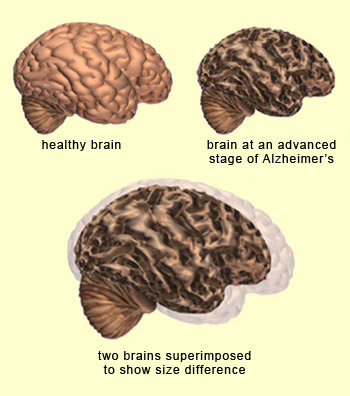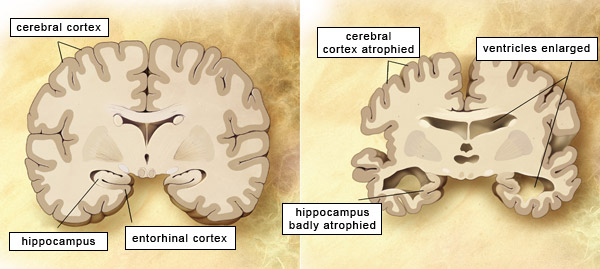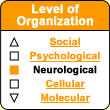|
|


|
|
| CORTICAL ATROPHY IN ALZHEIMER’S |
|
Alzheimer’s-type dementia is characterized by the gradual loss of important functions such as memory, language, and the ability to plan. It is a neurodegenerative process, meaning one in which a part of the nervous system deteriorates irreversibly.
In the case of Alzheimer’s, given the types of deficits involved, it is no surprise that the part of the nervous system affected is the cerebral cortex. |
 |
Thus, the main macroscopic effect observed in people with Alzheimer’s is atrophy of the cortex—the thin layer of grey matter whose myriad convolutions (folds) give the brain its characteristic appearance. This degeneration is essentially limited to the cortex and does not affect other, sub-cortical structures
the way that Parkinson’s and Huntington’s diseases do.
As a result of this cortical atrophy, over the course of 10 years, people with Alzheimer’s can lose as much as 8 to 10% of their brain mass, whereas in healthy people, the loss over 10 years is only about 2%.
This cortical atrophy results directly from the shrinking and death of the pyramidal cells of the cortex, which undergo a particular process of internal deregulation known as neurofibrillary degeneration.
This shrinkage of the cortex is especially pronounced in the inner temporal lobe, the part of the brain where the hippocampus is located. The hippocampus, which plays an essential role in forming new memories, is highly vulnerable from the earliest stages of Alzheimer’s.
As Alzheimer’s progresses, the fluid-filled spaces inside the brain known as ventricles become larger.

Cross-sections of a healthy brain (left) and a brain with extensive atrophy in the late stages of Alzheimer’s (right)
Source: National Institute on Aging, National Institutes of Health |
Lastly, neurons that use acetylcholine as a neurotransmitter are especially affected by Alzheimer’s.
The loss of these neurons results in a slowing of mental faculties, and some Alzheimer’s medications are designed to counter this process by increasing acetylcholine production
in the surviving neurons.
Thus the progression of Alzheimer’s, which results in significant damage to the brain in its advanced stages, is not a random process but rather one involving a specific sequence of changes.
|
|






